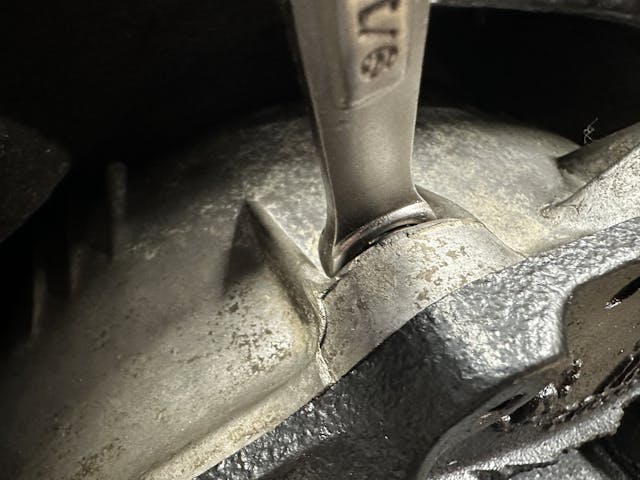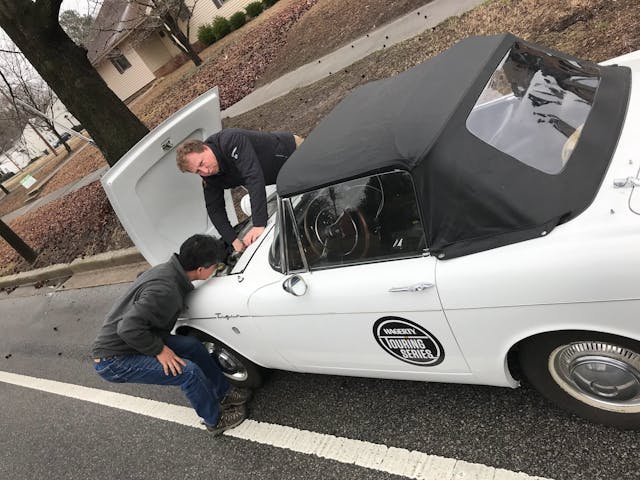Media | Articles
11 Rites of Passage for Every DIY Mechanic
Read all the books you want. Watch all the TV shows and YouTube mechanic videos that have ever been filmed. Sit and have a conversation with everyone who has turned a wrench. You still won’t be a mechanic, because practice and experience cannot be taught.
When younger enthusiasts recount certain adventures (or misadventures) to those with a few more years in the hobby, the seasoned folks will nod along. A mechanic’s rites of passage often need no explaining; by definition, these experiences have become universally accepted as ones that you must encounter and conquer to become proficient.
Which of these 11 rites of passage have you experienced, and which do you think changed you the most?
Rite of Passage #1: Roadside repair with makeshift parts
Whether on the road or in the shop, there comes a time when what you have is all you’ve got, and what you have just needs to work. Gaskets cut out of beer packaging, throttle cables made of shoestrings, or bailing wire on a part or piece that should be properly connected, but isn’t … If you understand a system well enough to engineer a functional fix on the fly, you truly understand how that system works.
Rite of Passage #2: Busted knuckles
You know the bolt is about to break free, so you give it a little extra oomph—and slam your hand into something. Usually, that something is heavy, rusty, or sharp … possibly, all three. Keep a record of your last tetanus shot handy, and know that we’ve all been there. Pulling towards yourself is often safer, except when it comes to cutting tools or other sharp implements.
Marketplace
Buy and sell classics with confidence
Rite of Passage #3: Trapped tools

The order of operations during disassembly and assembly is important—but you’ve got to pay attention to your tools, too. We’ve all been in situations when the excitement of a bolt coming loose makes us forget the limited space we’re working with, and suddenly our wrench is trapped between a bolt and a hard place.
Rite of Passage #4: Broken hardware

When a bolt chooses to Marie Antoinette itself, or threads stretch past the plasticity point and become unusable, progress can get tough. The fact of the matter is that rookies are more likely to break hardware, but there is a bit of a bell curve: As you tackle more and more projects, the quality of your work often rises; and then, as you gain confidence to handle the problems you now expect to encounter, the quality of your work tends to dip. Learning new methods for dealing with broken and stuck hardware is a never-ending quest for any wrench, green or seasoned.
Rite of Passage #5: Buying the shop manual
Just about everyone went through a phase when they felt as though they knew everything. Most advance out of such a state to understand that, even with everything they know, the shop manual knows more. Learning just how important and helpful a shop manual can be is often a freeing experience: Buying one is the first step to being self-sufficient because it allows you to solve problems without calling in experts or endlessly searching the web.
Rite of Passage #6: Disappearing parts
How else are you going to learn to organize your shop if you never experience the mildly panicked search for something you sat down right there? Everyone who ever gave you advice about doing DIY work probably told you to bag and tag parts and hardware, but most of us had to learn the benefits of organization the hard way to truly understand them.
Rite of Passage #7: Endless parts search

You saw that cool hunk of metal on the side of the road and just had to have it. Now you got it home and are excited to get to work and … Wait, there are no parts available for this? Sometimes the coolest models are the ones with the most problems and buying one that needs everything without realizing none of the parts exists is the gearhead’s version of falling in love with a crazy person: You often can’t give them what they need, and if you try, you’re going to be doing a lot of work (and probably spending a lot of money).
Rite of Passage #8: First rebuilt engine start-up
The thrum of a well-tuned engine is magnificent, but the stutter and cough of one chugging to life for the first time is even more enthralling. Was everything assembled correctly? Was anything forgotten? How is the combination of parts you chose going to work together? It all becomes clear with the first touch of the key. Weathering that storm of nerves is an experience unlike any other.
Rite of Passage #9: Ruined clothes
It was supposed to be a quick, clean job. Now that pair of jeans that used to be nice is stained with oil. (The situation is even worse if you’ve just ruined a pair of pants that your significant other specifically told you not to wear in the garage.) Typically when doing DIY work you dress to protect, not to impress. Hubris may protest, calling that an obvious truth, but the drawer of “work clothes” indicates we occasionally need a reminder.
Rite of Passage #10: Inclement weather moving in
Having a garage is a luxury that some of us take for granted. Most of us started by working on whatever we had wherever we could: Laying on our backs in gravel driveways, sitting cross-legged on the dirt of the back yard, or even leaning over core supports on the side of the street. If the sun was shining when you started work, your lack of protection from the elements becomes obvious as the clouds gather and the wind picks up. Being soaking wet, cold, and/or dirty while trying to assemble or diagnose your car is not fun, but we all must experience this misery to truly appreciate mild weather and good shelter.
Rite of Passage #11: Fixing what is not broken
The excitement to work on a project is sometimes so great that it must be satiated—even when there is work that needs to be done. I personally recall my father giving me the “if it ain’t broke, don’t fix it” speech while in my early teens; I had just made a mess of the garage floor taking apart something that had worked when I started and, more than likely, would never work correctly again. Poor thing.
Do you have to go through all of these to be a decent mechanic? Of course not, but many of us have experienced most, if not all, of these and more. Think we missed a rite of passage that changed you? Let us know about it in the comments below.
***
Check out the Hagerty Media homepage so you don’t miss a single story, or better yet, bookmark it. To get our best stories delivered right to your inbox, subscribe to our newsletters.






















First engine I rebuilt, Olds aluminum 215 cubic to install in a Chevy Vega. Wanted to upgrade to GM electronic ignition, so installed one from newer Buick engine, it dropped right in. Time to start engine and would not run, seemed to fire “occasionally” but not run. I’m sweating bullets thinking cam timed wrong or something else. Walked away for a day, came back, put timing light on it, cranked and it showed “in time” every few revolutions. More head scratching. In a moment of clear thought, I pulled the distributor and counted drive teeth, then compared to count on stock distributor…. drum roll…. one tooth different! Swapped drive gear, started on 1/2 engine revolution. Ran for several years after. Taught me that there is always a reason, you just need to find it. Happened close to 50 years ago, won’t ever forget it.
Had the same experience, the motor popped once in a while. Took the distributor out and found it missing teeth. Plastic gear, slant six.
If it went together to easily it is wrong tight and right
Busted Knuckles? Way back when, a buddy was changing the brake shoes on his old Chevy. I guess the job was going OK until he got to putting back the springs. We didn’t have any tools beyond basic stuff so he was pulling the spring with a pair of vice grips clamped onto the spring. The grips slipped off and since he had his face right there, he managed to take out two front teeth. Whoops! On another side of the picture, we used to make gaskets out of old cereal boxes when we didn’t have what we really needed. A piece of the cardboard box slathered in oil seemed to work for stuff like thermostat gaskets at least until you could get a real gasket.
I have used a photocopier to make gaskets. Just place the cover (motorcycle stuff) on the copier bed, press button and instant gasket (just cut out and punch holes) . If you do this at Office Despot, have the part covered in Seran wrap (prevent scratches to the glass of the photocopier) , to keep the owner from yelling at you. (like happened to me)
This article brought a smile to my face. I would never claim to hold the honor of being a mechanic however I’ve done many of these things! I couldn’t help but smile from remembering #10 and #11. The excitement I had to begin a tear down and turn every bolt in my driveway as my neighbors watched and shook their head…. Great article. Thank you
First start of a rebuilt engine. Rebuilt an old VW square back engine. First start cranked several times. Finally one “pop”. Looked in the rear view mirror to see a few flames coming from the engine. Finally did get it running.
Coast to coast trip in a “new to you’ car that has no business making a cross country trip. In my case it was a 23 year old Caterham that hadn’t been on the road for over a decade. That experience made me fearless when it comes to taking on mechanical issues I know nothing about.
I will never again strip paint off an entire vehicle. I had just built a three car garage with a loft and I had parts everywhere. Chemical stripper, sandpaper and stripping disc’s galore. It took weeks and what a mess! I will pay the thousands to have my next vehicle stripped and primed.
Never ever underestimate the time that it’s going to do the job, especially if what you’re working on is your sole means of transportation and/or this is the first time that you have attempted the repair. If you think that it’s going to take two hours, plan on five, minimum. When you hear of a technician knocking out a repair in half the book time, remember that the first few times doing that particular repair, they lost their asses so they’re making up for lost time and, since time is money, money.
That is for sure! I’m great at underestimating the time a job will take. Probably because I need to better track the time I spend looking for tools I set down, and parts runs for the inevitable part I now need.
every “5 minute job” turns into a 5 hour job.
The oil filter adapter on my 4 liter Ranger V6 had a slow drip – and both my wife and I were sick of the oil slick on the driveway so I ordered the 2 “O” rings from Rock Auto and went at it – figuring since it was only a single bolt holding it together I should have it finished in an hour or so at worst. Well, that bolt could not be removed without dropping the “Y” pipe – and it had not been off in 28 years. The12 mm exhaust studs were burned down to about 6 – being generous – and even with the “blue tip wrench” I broke the first one – and the second – and the 4th. No way to get to them with the manifolds installed – and not willing to risk breaking off the manifold bolts – which are single use and something like $10 a piece -and 6 per manifold IIRC the $60 per manifold was the least of the expense – ASSUMING none broke off – so it was out with the engine – and no way to remove engine and trans tigether that meant separating the 2 – with one bolt almist impossible to get out – and then the dowel pins were seized so I had to make a jack screw to jack between the bell housing and the cyl head. Turned into a 45 hour job —–burned the studs out of the manifolds with the torch(without damaging the threads – HOORAY!!!!) – should have replaced the clutch while I was at it – ended up doing half the job over again 8 months later when the clutch let go – – –
Ahhh, this brings back lots of fond memories. Some good, some bad, but all learning experiences nonetheless. Went thru all of them except #1, and I am proud of who I’ve become. Thanks for the walk down memory lane.
I was an inveterate tinkerer from the time I could pick up a tool, always curious about how things worked. One day when I was around 12, I disassembled the Briggs and Stratton engine on my Dad’s yard edger and had all the parts neatly organized on our back patio to proudly show him when he got home from work. Needless to say, he was not pleased and told me in no uncertain terms that when he got home from work the next day that the edger had better be in fully operational condition or I would be paying to fix it. The next morning, I got an early start to putting it back together, while in the meantime my Mom had contacted a nearby small engine repair shop, so in case my reassembly work was unsuccessful, we could run it to the shop and let them fix it. By mid-morning I had it fully reassembled and lo and behold, it started right back up after about four or five pulls of the starter rope! Now, bear in mind, this was a Briggs and Stratton engine, which would probably run with some parts missing and/or installed backwards! When my Dad got home, I proudly presented the fully assembled edger and told him to try it out. It started on the first pull! The look on his face was priceless – part disbelief and part pride! He told me, “that’s a great job, but don’t ever do something like that again…and since it’s running, go edge the yard!” My Mom and me got the biggest laugh out of that memory for years!
Learning that a picture can be worth a thousand words. When disassembling an engine, for example, take pictures, lots of pictures. They are often extremely helpful when your reassembling at a later date.
Finding the vice grip still on the bolt you worked on last time, or last year.
Making the wrong radiator hose work.
Making it back home!
I liked the 11 rites of passage but here is one that could be added. PPE while doing some work with a bench grinder, such as safety glasses.
The worst is when you bag and tag, but you still can’t find the right bolt you need because you have so many bags of bolts and pieces. “I swear it was right here!”
Maneuvering yourself inside your car to find a way to reach a spot. As an alternative, putting your feet or butt on almost every weight bearing surface (or some not) to put something back. I found out that I can stand on the seats of my Lotus to put the rear clamshell back on!
Finding out that new master cylinder that you bought last year is defective. And learning over and over that you can’t afford cheap.